Spotlight on New Staff: Mahmoud Elkasabi
This is the first in a series of posts introducing readers to new staff at The DHS Program. Welcome,Mahmoud!
Name: Mahmoud Elkasabi
Position title: International Survey Sampling Statistician
Languages spoken: English and Arabic
When not working, favorite place to visit: Chicago
Favorite type of cuisine: Mediterranean or Indian
Last good book you read: Azazeel, by Youssef Ziedan
Where would we find you on a Saturday? With my daughter and wife, watching TV and going out together.
First time you worked with DHS survey data: In my thesis for my master’s degree. I used the 2005 Egypt DHS to explore landline telephone ownership, and to examine the differences between the landline-households and the non-landline-households.
What is on your desk (or bulletin board/wall) right now? A lot of sampling textbooks.
What is your favorite survey final report cover? The Peru 2012 Continuous DHS . The art work is very innovative and different.
Favorite chapter or indicator, and why? Characteristics of Survey Respondents. This section gives me a quick idea about what a country looks like.
What’s your favorite way to access The DHS Program’s data? I usually use http://www.dhsprogram.com.
What population or health issue are you most passionate about? Why? I’m always passionate about the HIV testing results. HIV indicators provide you with a tool to track the change in the HIV knowledge, attitudes and behaviors.
What are you most looking forward to about your new position? To work closely with statisticians in different countries to develop the survey sampling design. Also, I’m looking forward to contributing to the capacity building of those statisticians, especially regarding the survey sampling designs and survey estimation. In addition, I also look forward to visiting different countries, seeing different cultures, and trying new food.
What has been your biggest surprise so far? It is not always boring to work with one survey. With The DHS Program, each country has a different flavor and challenges.
What do you look forward to bringing to The DHS Program (job-related or not!)? I’m excited to be a part of The DHS Program team and I’m looking forward to applying what I have learned, and to gain more experience from all of the staff.




Proud of you dear cousine and brother 🙂
Dearest Mahmoud, very proud of you. Very hopeful you will share your expertise and will be able to mentor junior Egyptian statisticians among others in different countries that you will have a chance to work in with dhs. Best of luck ALWAYS. Sahar El Tawila
Dear Mahmoud, very proud of you brother
Ahmad Abu Haidar
Dear Mahmoud,
You’ve been always a source of pride for your friends, family and professors. Not only because your keen to gain new knowledge and experience and then transfer them to others, but also because you have always been a role model yourself for how a real man should be.
Best of luck brother